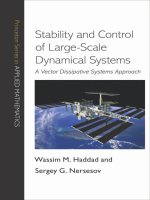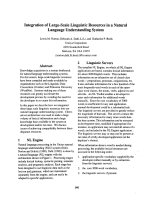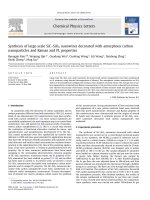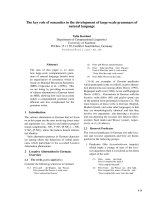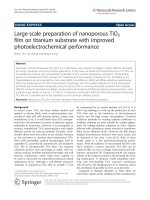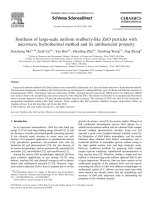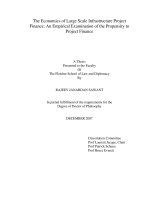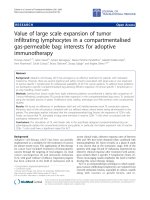Iterative solutions of large scale soil structure problems
Bạn đang xem bản rút gọn của tài liệu. Xem và tải ngay bản đầy đủ của tài liệu tại đây (13.74 MB, 219 trang )
ITERATIVE SOLUTIONS OF LARGE-SCALE SOIL
STRUCTURE PROBLEMS
TRAN HUU HUYEN TRAN
NATIONAL UNIVERSITY OF SINGAPORE
2014
ITERATIVE SOLUTIONS OF LARGE-SCALE SOIL
STRUCTURE PROBLEMS
TRAN HUU HUYEN TRAN
(B.Eng., NUS, Singapore)
A THESIS SUBMITTED
FOR THE DEGREE OF DOCTOR OF PHILOSOPHY
DEPARTMENT OF CIVIL AND ENVIRONMENTAL
ENGINEERING
NATIONAL UNIVERSITY OF SINGAPORE
2014
Declaration page
i
Declaration page
Declaration
I hereby declare that this thesis is my original work and it has been written by
me in its entirety. I have duly acknowledged all the sources of information
which have been used in the thesis.
This thesis has also not been submitted for any degree in any university
previously.
ACKNOWLEGEMENTS
ii
ACKNOWLEGEMENTS
First of all, I would like to thank my supervisor, Professor Phoon Kok Kwang.
Without his encouragement, his guidance, his advices on several topics, I
would not be able to finish this thesis. I, too, greatly appreciate my co-
supervisor, Professor Toh Kim Chuan for his patience and gentle guidance. . I
am also thankful to the members of my thesis committee, Dr. Chew Soon Hoe,
Professor Lee Fook Hou and Associate Professor Tan Sew Ann, for their
valuable reviews and advices on my thesis.
I thank my parents, my sister and my big extended family for always
supporting and trusting me. A lot of thanks to my close friends Thi, Liên,
Bằng, Khôi, Hải, for keep updating me with your travelling activities while I
locked myself in the office writing thesis, for cheering me up with all kinds of
gossip. Finally I sincerely thank my boyfriend, Chek Khoon, simply for your
presence.
My four years of Ph.D would be insufferable and miserable without friends in
Geotech Research group. It is the first time in my life I have the feeling of
belonging to a group in school. So yes, thanks a lot for your presence, for
discussing with me, chatting with me, giving peer pressure to me (well!). So
here you are, thanks to: Dr. Cheng Yonggang, Dr. Chen Xi, Dr. Anastiasia
Santoso, Dr. Krishna Bahdur Chauhary, Dr. Sindhu Tjahyono, Mr. Lu Yitan,
Mr. Tang Chong, Miss Ho Jiahui, Miss Cheng Zongrui, Mr. Zhang Lei, Mr.
Chin Bo, Dr. Sun Jie, Ms Ji Jiaming, Dr. Andy Tan, Dr. Tan Chzia Ykaw,
Miss Thiri Su, Dr. Ye Feijian, Dr. Chen Jian, Mr. Zhao Ben, Dr. Wu Jun, Miss
Li Yuping, Mr. Liu Yong, Mr. Yang Yu.
ACKNOWLEGEMENTS
iii
Table of Contents
DECLARATION PAGE I
ACKNOWLEGEMENTS II
TABLE OF CONTENTS III
SUMMARY VI
LIST OF TABLES VIII
LIST OF FIGURES X
LIST OF SYMBOLS XV
CHAPTER 1 INTRODUCTION 1
1.1 Introduction 1
1.1.1 Three-dimensional finite element analysis and iterative methods 1
1.1.2 Non-associated plasticity in geotechnical engineering 4
1.1.3 Iterative solvers for nonsymmetric linear systems 7
1.1.4 Preconditioners for nonsymmetric linear systems 11
1.2 Objective and Scope of the study 13
1.3 Computer hardware and software 14
1.4 Thesis outline 14
CHAPTER 2 LITERATURE REVIEW 16
2.1 Induced Dimension Reduction (IDR) method 16
2.1.1 Overview of IDR(s) method 16
2.1.2 Implementation of IDR(s) 19
2.2 Preconditioners for 1-by-1 nonsymmetric block matrix 20
2.2.1 Nonsymmetric linear systems resulted from drained and undrained
analysis 20
2.2.2 Jacobi and SSOR Preconditioners 21
2.2.3 Incomplete factorization preconditioners 23
2.3 Preconditioners for 2-by-2 nonsymmetric block matrix 27
2.3.1 Nonsymmetric linear systems resulted from Biot’s consolidation
equations 27
2.3.2 ILU and MSSOR preconditioner 29
2.3.3 Block preconditioners 30
2.4 Convergence criteria 35
ACKNOWLEGEMENTS
iv
2.4.1 Effect of spectral properties 35
2.4.2 Stopping criteria and tolerance of error 36
2.5 Summary 39
CHAPTER 3 ITERATIVE SOLVERS FOR NONSYMMETRIC LINEAR
SYSTEMS 40
3.1 Introduction 40
3.2 Problem description and theoretical background 40
3.3 Computational procedure 43
3.4 Comparison of IDR(s) and Bi-CGSTAB 46
3.5 Comparison of ILU0 and ILU(ρ, τ) 70
3.6 Effect of convergence criteria and iteration tolerance 74
3.6.1 Effect of the variation of iteration tolerance, i_tol 74
3.6.2 More discussion on the interaction of i_tol, NR_tol and load
increment 78
3.7 Eigenvalue distribution of nonsymmetric linear systems 83
3.8 Summary 85
CHAPTER 4 PRECONDITIONERS FOR 1-BY-1 BLOCK MATRICES:
DRAINED/UNDRAINED ANALYSIS 87
4.1 Introduction 87
4.2 Efficient preconditioning for a sequence of linear systems in drained
analysis 87
4.2.1 By forming the global stiffness matrix implicitly 89
4.2.2 By freezing the preconditioner 94
4.3 Effect of penalty method for prescribed degrees of freedom and
undrained analysis on IDR(s) and ILU0 preconditioner 106
4.3.1 Undrained analysis of the strip footing using effective stress method
111
4.3.2 Problem with ILU0 factorization 112
4.3.3 Recommendation for remedy 116
4.4 Summary 116
CHAPTER 5 PRECONDITIONERS FOR 2-BY-2 BLOCK MATRICES:
CONSOLIDATION ANALYSIS 119
5.1 Introduction 119
5.2 Problem description 119
ACKNOWLEGEMENTS
v
5.3 Comparison of preconditioners and effect of node ordering 123
5.3.1 Preconditioners derived from the 2-by-2 block ordering 123
5.3.2 Preconditioners derived from the natural ordering 137
5.3.3 Eigenvalue distribution 139
5.4 Undrained analysis with 2-by-2 block matrix 141
5.5 Applying the preconditioner updating schemes in Section 4.2.2 144
5.6 Summary 147
CHAPTER 6 APPLICATION OF PRECONDITIONERS ON
PRACTICAL GEOTECHNICAL PROBLEMS 149
6.1 Introduction 149
6.2 GeoFEA implementation 149
6.3 Drained analysis 150
6.3.1 Problem descriptions 150
6.3.2 Implementation of preconditioner updating schemes 152
6.4 Summary 154
CHAPTER 7 CONCLUSION AND RECOMMENDATION 156
7.1 Summary and conclusions 156
7.2 Limitations and recommendations 157
REFERENCE 159
APPENDIX A: NONLINEAR FINITE ELEMENT ANALYSIS 174
A.1 Pseudo-code for conventional and modified nonlinear FE analysis 174
A.2 Formulation of continuum tangent stiffness stress-strain matrix for Mohr-
Coulomb model 175
A.2.1 Rounding of Mohr-Coulomb yield surface 175
A.2.2 Return mapping method and continuum tangent stiffness stress-strain
matrix for Mohr-Coulomb model 176
APPENDIX B: SOURCE CODE IN FORTRAN 90 179
B.1 Subroutine for preconditioned IDR(s) to solve 1-by-1 block nonsymmetric
linear system 179
B.2 Subroutine for preconditioned IDR(s) to solve 2-by-2 block nonsymmetric
linear system 189
Summary
vi
Summary
Finite element (FE) method has become extremely popular numerical method
in geotechnical engineering. Soil is the main material in geotechnical
engineering and very often shows nonlinear and plastic behaviour. Mohr-
Coulomb model is a simple, popular and effective constitutive model to
simulate the plastic behaviour of soil. When the Mohr-Coulomb model is used
in numerical simulation, it is essential to adopt a non-associated flow rule to
obtain realistic results. The global stiffness matrix in FE analysis, which is
often large in size and highly sparse, becomes nonsymmetric. Little discussion
has been focused on the preconditioners for this class of nonsymmetric linear
system.
This thesis applies the Induced Dimension Reduction Method (IDR(s)) to
solve the large-scale nonsymmetric linear system. This IDR(s) method is
shown to be more effective than the current default method, Bi-CGSTAB. In
drained analysis, the global stiffness matrix is in form of 1-by-1 block matrix.
Incomplete LU factorization with zero fill-in (ILU0) is shown numerically to
be the most efficient preconditioner for this matrix among Jacobi, SSOR and
ILUT(ρ, τ). In consolidation analysis, the global stiffness matrix is in form of
2-by-2 block matrix. A diagonal block preconditioner is shown to be the most
efficient block preconditioner. This diagonal block preconditioner uses ILU0
as the approximation of the soil stiffness matrix and a simple diagonal matrix
as the approximation of the Schur complement of the 2-by-2 block matrix
For non-associated MC, nonlinear FE analysis is required and a sequence of
large-scale nonsymmetric linear systems has to be solved continuoustly. Two
techniques to save the total simulation time in dealing with sequence of
nonsymmetric linear systems are recommended for both 1-by-1 and 2-by-2
block matrix as following: 1) Forming the elastoplastic global stiffness matrix
implicitly by forming the elastic global stiffness matrix once and update the
low-rank matrix at every NR iteration; 2) Updating the preconditioner one
time at the beginning of the simulation or updating preconditioners at the
beginning of each load steps. When these two techniques are used
Summary
vii
concurrently, the total simulation time of 1-by-1 block matrix can be reduced
60 percent compared with the default procedure.
List of tables
viii
List of tables
Table 2.1 Statistics that can be used to evaluate an incomplete factorization
(Chow & Saad
43
, 1997) 26
Table 2.2: Tolerance values for various iterative methods used in literatures . 39
Table 3.1: Parameters of Mohr-Coulomb yield criterion 41
Table 3.2: Ultimate bearing capacity of the strip footing and square footing on
the homogenous soil layer and the maximum applied pressure used in
numerical experiments 42
Table 3.3: 3D finite element meshes of the strip footing 47
Table 3.4: Comparison of Bi-CGSTAB and IDR(s) with different
preconditioners. Soil profile 1 is used. Matvec and time in second are reported
at the last load step, 280 kPa. 48
Table 3.5: Comparison of Bi-CGSTAB and IDR(s) with different
preconditioners. Soil profile 2 is used. Matvec and time in second are reported
at the last load step, 26 kPa. 49
Table 3.6: Comparison of Bi-CGSTAB and IDR(s) with different
preconditioners. Soil profile 3 is used. Matvec and time in second are reported
at the last load step, 40 kPa. 50
Table 3.7: 12×3×12 mesh – Summary of NR iteration, average Krylov
iteration and yielded Gauss point. Soil profile 1 is used 80
Table 3.8: 24×6×24 mesh – Summary of NR iteration, average Krylov
iteration and yielded Gauss point. Soil profile 1 is used 81
Table 3.9: 32×8×32 mesh – Summary of NR iteration, average Krylov
iteration and yielded Gauss point. Soil profile 1 is used 82
Table 4.1: 3D FE meshes of the square footing resting on soil profile 1 and 2
88
Table 4.2: Ultimate bearing capacity of the strip footing and square footing on
the homogenous soil layer and the maximum applied pressure used in
numerical experiments 89
Table 4.3: Different schemes to update ILU0 preconditioner during the
simulation 99
Table 4.4: Properties of Mohr-Coulomb soil 107
Table 4.5: Total passive resistance on the 1m height smooth vertical wall 107
Table 4.6: Total stress parameters of Mohr-Coulomb yield criterion 111
List of tables
ix
Table 4.7: Ultimate bearing capacity of strip footing on homogenous soil
layers 111
Table 4.8: ILU statistics and possible reasons of failure for soil profile 1 –
Stiff clay 114
Table 4.9: ILU statistics and possible reasons of failure for soil profile 2 –
Dense sand 115
Table 5.1: 3D finite element meshes of the square footing 121
Table 5.2: Effective parameters of the soil following a non-associated MC
model 121
Table 5.3: Loading information 122
Table 5.4: Comparison of diagonal block preconditioner M
d
and constrained
block preconditioner M
c
. Time presented in brackets is overhead time
including time required to form preconditioners and extracting required block
matrices. Soil profile 1 is used. Results are reported at the last load step. 125
Table 5.5: Comparison of diagonal block preconditioner M
d
and constrained
block preconditioner M
c
. Time presented in brackets is overhead time
including time required to form preconditioners and extracting required block
matrices. Soil profile 2 is used. Results are reported at the last load step. 126
Table 5.6: Matrix-vector multiplications required by IDR(s) preconditioned
with M
c
(
31
ˆ
,
ˆ
SK
). Soil profile 2 is used. The applied pressure is 3kPa when
yielded Gauss points first appear and the linear system becomes nonsymmetric.
128
Table 5.7: Ultimate bearing capacity of square footing q
f
(kPa) 141
Table 5.8: Different schemes to update ILU0 preconditioner during the
simulation 144
Table 6.1: Geomaterials used in the laterally loaded pile and the tunnelling
excavation problems 151
List of figures
x
List of figures
Figure 1.1: Isotropic Consolidation (loading) and Swelling Curves for London
Clay (Henkel
79
, 1959) 4
Figure 1.2: Conventional undrained triaxial compression test on NC soil: (a) p’:
q effective stress plane; (b) q: ε
q
stress: strain plot. (Wood
179
, 1991, p.131) 5
Figure 1.3: Conventional undrained triaxial compression test on LOC soil: (a)
p’: q effective stress plane; (b) q: ε
q
stress: strain plot. (Wood
179
, 1991, p. 132)
5
Figure 1.4: Numerical result of Cam clay model: q: ε
q
stress:strain in drained
triaxial compression tests with constant mean stress (δp
0
= 0) (κ = 0.05, G =
1500kPa, λ = 0.25, M = 1.2) (overconsolidation ratio p’
0
/p’
i
in range 1-5, p
0
=
100kPa (Wood
180
, 2004, p. 160) 5
Figure 1.5: Results of triaxial drained test on dense sand (Hettler &
Vardoulakis
81
, 1984) 7
Figure 1.6: Results of triaxial drained tests on saturated Ham River loose sand
(Bishop
25
, 1966) 7
Figure 2.1: IDR theorem (Sonneveld & Gijzen
162
, 2008) 16
Figure 2.2: Preconditioned IDR(s)-biortho with preconditioner M (Gijzen &
Sonneveld
70
, 2010) 18
Figure 2.3: Preconditioned BiCGSTAB method with preconditioner M
(Barrett et al.
16
, 1994) 19
Figure 2.4: Sparsity pattern of 1-by-1 block matrix 21
Figure 2.5: Pseudo-code for ILUT (Saad
144
, 2003, pp. 307) 25
Figure 2.6: Pseudo-code to compute condest of ILU preconditioner 27
Figure 2.7: Sparsity pattern of 2-by-2 block matrix 29
Figure 2.8: Pseudo-code to compute preconditioning step M
d
-1
[u;v] (Toh et
al.
166
, 2004) 32
Figure 2.9: Pseudo-code to compute preconditioning step M
c
-1
[u;v] (Toh et
al.
166
, 2004) 33
Figure 2.10: Pseudo-code to compute preconditioning step M
t-L
-1
[u;v] and M
t-R
-
1
[u;v] (Toh et al.
166
, 2004) 35
Figure 2.11: Ellipses containing the spectrum of A. (A): real eigenvalues; (B)
Purely imaginary eigenvalues (Saad
144
, 2003, pp. 195) 36
List of figures
xi
Figure 2.12: Comparison of stopping criteria when GMRES is used to solve
the linear system from FE discretization of 2D advection-diffusion problem. ν
is the diffusion parameter. (Arioli et al.
9
, 2005) 38
Figure 3.1: (a) 3D FE mesh of strip footing; (b) Soil profile 3: Heterogenous
soil consisting of alternate dense sand and stiff clay 41
Figure 3.2: Pseudo-code to compute matrix-vector multiplication with a
preconditioned matrix 43
Figure 3.3: Comparison of Bi-CGSTAB and IDR(s) with s = 1, 4, 6, 10, and
20. Mesh size 12×3×12. Soil profile 1 is used. 54
Figure 3.4: Comparison of Bi-CGSTAB and IDR(s) with s = 1, 4, 6, 10, and
20. Mesh size 24×6×24. Soil profile 1 is used. 56
Figure 3.5: Comparison of Bi-CGSTAB and IDR(s) with s = 1, 4, 6, 10, and
20 Mesh size 32×8×32. Soil profile 1 is used. All the methods do not converge
when there is no preconditioner hence this case is not plotted here. 58
Figure 3.6: Comparison of Bi-CGSTAB and IDR(s) with s = 1, 4, 6, 10, and
20. Mesh size 12×3×12. Soil profile 2 is used. 60
Figure 3.7: Comparison of Bi-CGSTAB and IDR(s) with s = 1, 4, 6, 10, and
20. Mesh size 24×6×24. Soil profile 2 is used. 62
Figure 3.8: Comparison of Bi-CGSTAB and IDR(s) with s = 1, 4, 6, 10, and
20. Mesh size 32×8×32. Soil profile 2 is used. All the methods do not
converge when there is no preconditioner hence this case is not plotted here. 64
Figure 3.9: Comparison of Bi-CGSTAB and IDR(s) with s = 1, 4, 6, 10, and
20. Mesh size 16×3×16. Soil profile 3 is used. 66
Figure 3.10: Comparison of Bi-CGSTAB and IDR(s) with s = 1, 4, 6, 10, and
20. Mesh size 24×6×24. Soil profile 3 is used. 68
Figure 3.11: Comparison of Bi-CGSTAB and IDR(s) with s = 1, 4, 6, 10, and
20. Mesh size 32×8×32. Soil profile 3 is used. All the methods do not
converge when there is no preconditioner hence this case is not plotted here. 70
Figure 3.12: Comparison of ILU0 and ILUT(ρ, τ). Soil profile 1 is used with
problem size of 12×3×12. 71
Figure 3.13: Comparison of ILU0 and ILUT(ρ, τ). Soil profile 1 is used with
problem size of 24×6×24 72
Figure 3.14: Comparison of ILU0 and ILUT(ρ, τ). Soil profile 1 is used with
problem size of 32×8×32 73
Figure 3.15: Comparison of different i_tol. Soil profile 1 is used. 75
Figure 3.16: Comparison of different i_tol. Soil profile 2 is used. 76
List of figures
xii
Figure 3.17: Interaction of i_tol, NR_tol and load increment 83
Figure 3.18: Eigenspectra of matrix (a) K
e
; (b) Unpreconditioned K
ep
; (c) K
ep
preconditioned with ILU0
.
Problem size 12×3×12 with soil profile 1 84
Figure 3.19: Characteristics of eigenspectrum: (a) Maximum and minimum
eigenvalue; (b) Maximum imaginary part of eigenvalues; (c) Condition
number of matrix X (Eq.(2.30)). Problem size 12×3×12 with soil profile 1 is
used. 85
Figure 4.1: 3D finite element mesh of the square footing 88
Figure 4.2: Ratio of applied pressure q over the bearing capacity q
f
versus
percentage of yielded Gauss points in the 3D mesh of: (a)(c) Strip footing,
(b)(d)Square footing 91
Figure 4.3: (a) (b) Ratio of time to form Δ and K
ep
over time to form K
e
; (c)
(d)Ratio of time to form Δ and K
ep
over total time consumed in each NR
iteration when IDR( 6) with ILU0 is used to solve the linear systems. 92
Figure 4.4: Comparison of efficiency of ILU0-K
e
and ILU0-K
ep
. Soil profile 1
is used 95
Figure 4.5: Comparison of efficiency of ILU0-K
e
and ILU0-K
ep
. Soil profile 2
is used 96
Figure 4.6: Ratio of total time consumed in each NR iteration by method (1):
using IDR(6) with ILU0-K
e
and forming Δ over method (2): using Bi-
CGSTAB with ILU0-K
e
and forming K
ep
.(a)(c) Strip footing. (b)(d) Square
footing 97
Figure 4.7: Typical trend of variation of N
y
and matvec required by IDR(6)
with ILU0-K
ep
within each load step 98
Figure 4.8: Comparison of different schemes of updating ILU0 preconditioner.
Strip footing resting on Soil profile 1 is considered. 100
Figure 4.9: Comparison of different schemes of updating ILU0 preconditioner.
Strip footing resting on Soil profile 2 is considered. 101
Figure 4.10: Comparison of different schemes of updating ILU0
preconditioner. Square footing resting on Soil profile 1 is considered 102
Figure 4.11: Comparison of different schemes of updating ILU0
preconditioner. Square footing resting on Soil profile 2 is considered 102
Figure 4.12: Comparison of cumulative solution time of IDR(6) versus Bi-
CGSTAB 105
Figure 4.13: 3D FE mesh for the passive pressure analysis 106
List of figures
xiii
Figure 4.14: Matrix-vector multiplications of IDR(6) with ILU0-K
ep
when
solving the retaining wall subjected to prescribed horizontal displacements.
Soil profile 1 is used. 109
Figure 4.15: Matrix-vector multiplications of IDR(6) with ILU0-K
ep
when
solving the retaining wall subjected to prescribed horizontal displacements.
Soil profile 2 is used. 110
Figure 4.16: Typical relative residual norm of an unstable ILU0 preconditioner:
(a) IDR(6) method; (b) Bi-CGSTAB method 112
Figure 5.1: (a) 3D mesh of the square footing; (b) Ramp loading 120
Figure 5.2: Comparison of M
d
and M
c
with variation of approximations of K
ep
and S. Mesh size of 16×16×16 and soil profile 1 is used. 129
Figure 5.3: Comparison of M
d
and M
c
with variation of approximations of K
ep
and S. Mesh size of 20×20×20 and soil profile 1 is used. 130
Figure 5.4: Comparison of M
d
and M
c
with variation of approximations of K
ep
and S. Mesh size of 24×24×24 and soil profile 1 is used. 131
Figure 5.5: Comparison of M
d
and M
c
with variation of approximations of K
ep
and S. Mesh size of 16×16×16 and soil profile 2 is used. 132
Figure 5.6: Comparison of M
d
and M
c
with variation of approximations of K
ep
and S. Mesh size of 20×20×20 and soil profile 2 is used. 133
Figure 5.7: Comparison of M
d
and M
c
with variation of approximations of K
ep
and S. Mesh size of 24×24×24 and soil profile 2 is used. 134
Figure 5.8: Comparison of M
d
(
13
ˆ
,
ˆ
SK
) versus MSSOR and ILU0. Soil profile
1 is used 135
Figure 5.9: Comparison of M
d
(
13
ˆ
,
ˆ
SK
) versus MSSOR and ILU0. Soil profile
2 is used 136
Figure 5.10: The effect of node ordering in the global stiffness matrix on ILU0
and MSSOR preconditioner 138
Figure 5.11: Typical relative residual norm of an unstable ILU0 preconditioner
when the global stiffness matrix is in natural ordering and soil profile 1 is used.
139
Figure 5.12: Eigenspectrum of: (a) the elastic global stiffness matrix; (b) the
elastoplastic global stiffness matrix the final load step of 130kPa; (c) the
elastoplastic global stiffness matrix preconditioned with M
d
(
13
ˆ
,
ˆ
SK
). Soil
profile 1 is used with the 8×8×8 FE mesh. 140
List of figures
xiv
Figure 5.13: Characteristics of eigenspectrum: (a) Maximum and minimum
eigenvalue; (c) Condition number of matrix X (Eq.(2.30)). Soil profile 1 is
used with the 8×8×8 FE mesh. 140
Figure 5.14: Effect of kΔt on the convergence of IDR(6) + M
d
(
13
ˆ
,
ˆ
SK
) 142
Figure 5.15: Excess pore pressure at the point right below the square footing
143
Figure 5.16: Comparison of different schemes of updating block
preconditioners. Square footing resting on Soil profile 1 is considered. 146
Figure 5.17: Comparison of different schemes of updating block
preconditioners. Square footing resting on Soil profile 2 is considered. 147
Figure 6.1: 3D FE mesh of: (a) Laterally loaded pile; (b) Tunnelling
excavation 151
Figure 6.2: (a) Dimension and boundary condition of the tunnelling problem;
(b) Method used for the tunnel construction using TBM (Mroueh &
Shahrour
117
, 2008) 152
Figure 6.3: Comparison of preconditioner updating scheme in drained analysis
of: (a)(b) Laterally loaded pile; (c)(d) Tunnelling problem. 153
Figure 6.4: Comparison of cumulative solution time of IDR(6) versus Bi-
CGSTAB 154
Figure 6.5: Ratio of the time to form K
ep
over total time consumed in each NR
iteration when IDR( 6) with ILU0-K
ep
is used to solve the linear systems in: (a)
Laterally loaded pile; (b) Tunnelling excavation 154
Figure 1: Mohr-Coulomb yield surface space in (Abbo
2
, 1997): (a) Octahedral
plane; (b) Principal stress space 178
Figure 2: Backward Euler return mapping method (Crisfield
46
,1987): (a) One-
vector return; (b) Two-vectored return 178
List of symbols
xv
List of symbols
(.)
T
transpose of a function
|.|
absolute value or modulus of a number
║.║
norm of a function
1D
one-dimensional
2D
two-dimensional
3D
three-dimensional
a
real variable
a
ij
entry of matrix A
A
general matrix; matrix variable
A
~
preconditioned matrix A
b
right hand side vector
b
~
preconditioned right hand side vector
B
element strain-displacement matrix (Eq.(2.1)); or
displacement-pore pressure coupling matrix (Eq.(2.8));
or the width of the shallow foundation
BE
boundary element
Bi-CG
biconjugate gradient
Bi-CGSTAB
biconjugate gradient stabilized
c’
effective cohesion
c
u
Undrained/total cohesion
C
fluid stiffness matrix
CG
conjugate gradient
CGS
conjugate gradient square
CPU
central processing unit
CSC
compressed sparse column
CSR
compressed sparse row
List of symbols
xvi
det(.)
determinant of a function
diag(.)
diagonal matrix consisting of leading diagonal entries in
argument
D
embedment depth of shallow foundation
D
e
elastic effective stress-strain matrix
D
ep
elastoplastic effective stress-strain matrix
D
~
diagonal matrix variable
DOFs
degrees of freedom
E’
effective Young’s modulus
E
u
total Young’s modulus
f
yield surface function
F
applied load, righ-hand-side of the linear system
F
~
righ-hand-side vector modified by preconditioner
FE
finite element
FEM
finite element
g
plastic potential function
G
shear modulus
G
j
nested Krylov subspaces in IDR(s) method
GMRES
generalized minimal residual
H
matrix variable
i, j, k
integer variables
i_tol
tolerance for relative residual
I
identity matrix
I(.)
identity matrix of the size of the argument
I
1
first stress invariant
IDR(s)
induced dimension reduction method
ILU
incomplete LU decomposition
List of symbols
xvii
ILU0
incomplete LU factorization with no fill-in
ILU0(.)
ILU0 factorization of the matrix in the argument
ILUT(ρ, τ)
incomplete LU factorization with dual control
parameters for fill-in
J
2
second stress invariant
K
global stiffness matrix
K
ˆ
approximation of K
ep
K
e
elastic global stiffness matrix
K
ep
elastoplastic global stiffness matrix
K
w
bulk modulus of water
K
~
preconditioned matrix K
K(u)
stress stiffness matrix as a function of
LOC
lightly over-consolidated
L
A
strictly lower triangular part of
max(.)
maximum value of a function
min(.)
minimum value of the function
M
(in Figure 1.4) slope of the critical state line
M
preconditioner
M
c
block constrained preconditioner
M
d
diagonal block preconditioner
M
J
Jacobi preconditioner
M
L
left preconditioner
M
R
right preconditioner
M
t-L
triangular block preconditioner for left preconditioning
M
t-R
triangular block preconditioner for right preconditioning
matvec
matrix-vector multiplication
MC
Mohr-Coulomb model
List of symbols
xviii
n
porosity of soil
N
the dimension of total linear system, e.g. the dimension
of matrix A
N
γ
, N
c
, N
q
bearing capacity factors
NC
normally consolidated clay
NCL
normally consolidated line
NK
Newton-Krylov method
NR
Newton-Raphson iterative method
NR_tol
Relative tolerance of Newton-Raphson iteration
P
shadow space in IDR(s) method
p
ex
excess pore pressure vector
p
0
’
reference size of yield locus of Cam-clay model
p
i
’
mean effective stress
PC(s)
personal computer(s)
PCG
preconditioned conjugate gradient
q
deviator stress
q
max
maximum applied load
q
f
ultimate bearing capacity
QMR
quasi-minimal residual
QMR-GSTAB
Quasi-minimal residual variant of the Bi-CGSTAB
algorithm
r
residual vector
r
(i)
residual vector at the i iteration step
s
dimension of the shadow space in IDR(s) method
S
Schur complement
S
ˆ
approximation of S
SSOR
symmetric successive over-relaxation
List of symbols
xix
t
0
maximum loading time
u
displacement vector
u
~
displacement vector modified by preconditioner
u
0
trial displacement vector
x
local spatial coordinate; vector variable
x
(0)
initial guess of solution
x
(i)
solution vector at i-th iteration
X
matrix variable
U
A
strictly upper triangular part of
v
vector variable
w
p
penalty number
y
vector variable
z
integer variable
α
scaling parameter in GJ preconditioner or the increment
of percentage of yielded Gauss point
Δ
low-rank matrix
Δ(.)
incremental form of the argument
Δt
time step
Δλ
plastic multiplier
Δλ
1
plastic multiplier from first yield surface in two-
vectored return method
Δλ
2
plastic multiplier from second yield surface in two-
vectored return method
ε
q
deviator strain
θ
Lode angle or time stepping factor
κ
the swelling or recompression index
κ(.)
condition number of the argument matrix
λ
(in Figure 1.4) slope of normal compression line in ν:
List of symbols
xx
lnp’ plane
λ
eigenvalue
λ
max
maximum eigenvalue
λ
min
minimum eigenvalue
|λ|
modulus of eigenvalue
|λ|
max
maximum modulus of eigenvalue
|λ|
min
minimum modulus of eigenvalue
σ
x
, σ
y,
σ
z
normal stress in X-, Y- and Z-directions, respectively
τ
xy
, τ
yz
, τ
xz
shear stress in XY-, YZ-, and XZ-directions,
respectively
ϕ
friction angle
ψ
dilation angle
ω
input parameter in IDR(s) or relaxation parameter in
SSOR
∂(.)
partial derivative of a function
summation of a function over the range of index to
set of complex numbers
set of real numbers
vector space of real N-vectors
vector space of real N-by-N matrices
CHAPTER 1 INTRODUCTION
1
CHAPTER 1 INTRODUCTION
1.1 Introduction
1.1.1 Three-dimensional finite element analysis and iterative
methods
Finite element method (FEM) is an extremely popular numerical method in
geotechnical engineering for the last thirty years (Potts & Zdravkovic
137
,
1999). Analyses of geotechnical problems using FEM are performed
countlessly in research and practice (Migliazza et al.
112
, 2009; Almeida e
Sousa et al.
5
, 2011; Hashash et al.
77
, 2011; Lee et al.
99
, 2011; Hata et al.
78
,
2012). Several finite element (FE) packages are developed for research
purpose such as ICFEP (Potts & Zdravkovic
137
, 1999), PECPLAS
(Shahrour
153
, 1992), SNAC (Abbo & Sloan
4
, 2000) and commercial purpose
such as GeoFEA
67
(2006), GeoStudio
68
(2012), PLAXIS 2D
133
and 3D
134
(2012).
With the development of underground construction and the computational
ability of modern computers, three-dimensional (3D) FE analyses are in great
demand to simulate realistic soil structure interactions. Although real
geotechnical problems are three-dimensional (3D) in nature, simplified two-
dimensional (2D) plane strain or axisymmetric models are preferable in the
past due to the lack of graphical interpretation for 3D models and slow
computational ability (Augarde & Burd
10
, 1995). Now even personal
computers (PC) can process 3D models smoothly hence graphical
interpretation is not a hindrance. Moreover, certain geotechnical problems
cannot be simplified into plane strain or axisymmetric models and require full
3D analyses such as pile-soil interaction (Kahyaoglu et al.
91
, 2009; Peng et
al.
127
, 2010; Kelesoglu & Springman
93
, 2011), deep excavation (Faheem et
al.
56
, 2004; Zdravkovic et al.
186
, 2005; Hashash et al.
77
, 2011; Lee et al.
99
,
2011), and tunneling process (Mroueh & Shahrour
116, 117
, 2003, 2008;
Migliazza et al.
112
, 2009).
FE discretization results in a linear system of the form,
CHAPTER 1 INTRODUCTION
2
FKu
(1.1)
with N is the number of unknown degrees of freedom, K
N×N
is the
stiffness matrix, u
N
is the unknown vector, F
N
is the applied force
vector. 3D models are well-known for containing hundreds of thousand
unknowns (Lee et al.
99
, 2011; Hata et al.
78
, 2012) and the stiffness matrix K is
normally large but highly sparse. The large number of unknowns results in
long computation time and this is the very hindrance of 3D FEM analysis.
This thesis is motivated to reduce this computation time by certain
computational techniques.
Theoretically, the exact solution of Eq.(1.1) is
FKu
1
(1.2)
with K
-1
denotes the inverse matrix of K. Direct methods can find this exact
solution after a fixed number of operations in exact arithmetic (Quarteroni et
al.
139
, 2007). Preferable direct methods are Gauss elimination and its modified
forms, which require O(N
3
) flops (Isaacson & Keller
84
, 1994; Quarteroni et
al.
139
, 2007). When N is in the order of hundreds of thousand as in 3D FE
model of geotechnical problems, direct methods are not suitable for solving
Eq.(1.2) due to prohibitively expensive computational cost and memory
requirement.
Iterative methods and specifically Krylov subspace iterative methods are
recommended to efficiently solve large and sparse linear systems (Barrett et
al.
16
, 1994; Saad
144
, 2003). Iterative methods aim to generate a series of
approximate solution, x
(i)
, that converges to the exact solution (1.2) with any
initial guess, x
(0)
. Iterative methods access the linear system through matrix-
vector multiplication (matvec) and this operation can be done efficiently when
the matrix K is highly sparse as in the case of Eq.(1.1). The iteration process
can be stopped when the approximate solution is within some desired accuracy
level. This feature is very useful in geotechnical engineering since the system
need not be solved to high accuracy because soil is inherently variable hence
CHAPTER 1 INTRODUCTION
3
there are uncertainties in soil properties and soil models (Whitman
176
, 2000;
Phoon
129
, 2008).
Krylov subspace iterative methods are the most popular choice in the 20
th
century (Saad & Vorst
146
, 2000; Gutknecht
75
, 2007). Commercial FE
softwares like PLAXIS
134
(2012) and ABAQUS
1
(2010) use Krylov iterative
methods as linear system solvers. The advantage of Krylov iterative methods
over classical stationary methods is that Krylov iterative methods converge to
the exact solution in at most N iterations in exact arithmetic (Gurknecht
75
,
2007) and normally converge earlier than that. However, N iterations are still
expensive when N is in order of hundreds of thousands and with the presence
of rounding errors, Krylov methods may require more than N iterations to
converge.
Preconditioning is the main technique to accelerate the convergence of Krylov
iterative methods (Freund et al.
63
, 1992; Saad & Vorst
146
, 2000; Ferronato
58
,
2012). Preconditioning technique is the process of modifying the matrix K to a
new matrix
K
~
such that the later possesses spectral properties for faster
convergence of Krylov iterative methods. It is well known that preconditioners
are important in improving the convergence and efficiency of Krylov iterative
methods. In geotechnical engineering, preconditioners have only been
developed recently for specific geotechnical problems like Biot’s
consolidation (Chan et al.
36
, 2001; Phoon et al.
130
, 2004; Chen et al.
42
, 2006;
Bergamaschi et al.
22
, 2007; Ferronato et al.
59
, 2010) and soil-structure
interactions (Chauhary
37
, 2010). These discussions have been focused on
linear elastic material and symmetric linear systems. However, from the
practical point of view, linear elastic model is not sufficient to simulate the full
range of realistic behaviour of soil. For example, in deep excavations with
wall in cantilever mode, many discussions highlight that plastic strain of the
soil is generated at very small wall displacement (Jardine et al.
85
, 1986;
Whittle et al.
177
, 1993; Ou & Kung
122
, 2004; Plumey et al.
135
, 2010). Another
example is laterally loaded piles in which plastic zones form at the top of the
piles even at relatively low working loads (Liu & Meyerhof
104
, 1987; Brown
& Shie
31
, 1990; Yang & Jeremic
183
, 2002; Motta
114
, 2013). Besides, it is well-
